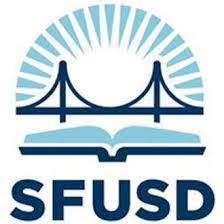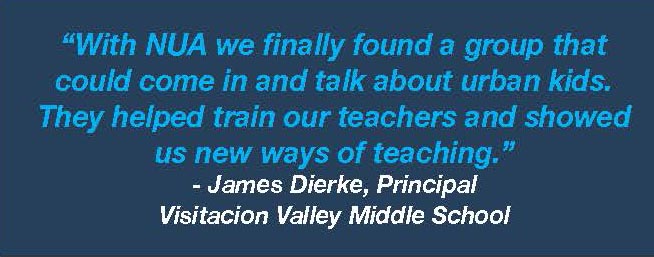NUA Working In San Francisco To Raise Achievement
Visitacion Valley Middle School in San Francisco is a great example of what can happen with the right leadership, teamwork, consistency and blend of student-focused programs.
Not too long ago, Visitacion Valley shared the challenges faced by many of our nation’s urban schools. It had low academic performance, poor attendance, high suspensions and high staff turnover rates. It’s no wonder the community had a negative image of the school.
 In 1999, Visitacion Valley was designated the lowest performing middle school in the district. That was also the year James Dierke became the principal and began to turn things around, eventually building a solid team of educators who wanted to assist in making a difference.
In 1999, Visitacion Valley was designated the lowest performing middle school in the district. That was also the year James Dierke became the principal and began to turn things around, eventually building a solid team of educators who wanted to assist in making a difference.
Not only has academic performance greatly improved, but for the past three years suspensions have decreased significantly. An average of 90 suspensions per year was normal until 2009, when the suspension rate dropped to just over a dozen in fall of 2010. Today, every one of the school’s teachers is fully credentialed.
Principal Dierke has done a lot to change the culture and expectations of his school, although, he singles out the National Urban Alliance for Effective Education (NUA) as one of the leading factors contributing to the recent spikes in overall achievement on state performance indicators.
Visitacion Valley was one of 10 San Francisco Unified School District (SFUSD) sites that partnered with the NUA as part of a district effort launched in 2009 to accelerate student achievement through professional development designed to promote students’ high intellectual performances. The 10 schools were chosen primarily due to the large number of underachieving students they served. The NUA/SFUSD partnership reached more than 4,600 K-12 students, 125 teachers and covered 16 subjects.
Most importantly for Dierke at Visitacion Valley, he and his teachers had professional development experts who understood his school’s needs. “With NUA we finally found a group that could come in and talk about urban kids,” said Dierke, the National Association of Secondary School Principals 2008 Middle School Principal of the year.
“They helped train our teachers and showed us new ways of teaching,” he added of the NUA. “They brought a new and respected opinion and experience.”
 Teachers and students now are assigned to academic families that use a variety of technology, cross-curricular writing programs and project-based and standards-based instructional programs. The staff formed an NUA Leadership committee to help plan professional development based on the needs of the staff.
Teachers and students now are assigned to academic families that use a variety of technology, cross-curricular writing programs and project-based and standards-based instructional programs. The staff formed an NUA Leadership committee to help plan professional development based on the needs of the staff.
Double-Digit Improvements
NUA mentors also worked with teachers in all content areas, engaging them with high operational practices that can be used in social studies, math or language arts. Those practices – designed based on cognitive and neuroscience research – provide a new approach to working with underachieving students of color and addressing the impact of culture on cognition, language and motivation.
NUA-led seminars were held for district office staff, school leaders, coaches and teachers. The seminars built on the district’s goal to develop professional learning communities that are motivated to share and expand current levels of expertise.
With teachers’ guidance, students use visual tools, story boards and journals to learn and to demonstrate their learning. The effort is paying off in a big way. There was a 16-point gain in 6th grade math and an 18-point gain in 8th grade social studies, while the school made a 40-point gain overall on state assessments. All the students made gains. The school tested 99% of the students in 2009-2010.
Principal Dierke said that the NUA training has “most definitely” helped to improve student performance at his school, especially in the 2009-10 testing cycle. “We made a 40-point gain on the California Standards Test (CTS). All subgroups made double-digit improvements, not just the top kids,” he said. “The practices were well taught and easy to implement. Our staff has great professional respect for our NUA trainers. We were very fortunate to have their services.”
Carlos Garcia, Superintendent of SFUSD agrees with the teachers and principals of his district who are telling him about the progress they are making with their students thanks to NUA. As Superintendent Garcia put it: “I would like to see NUA in all my schools”
